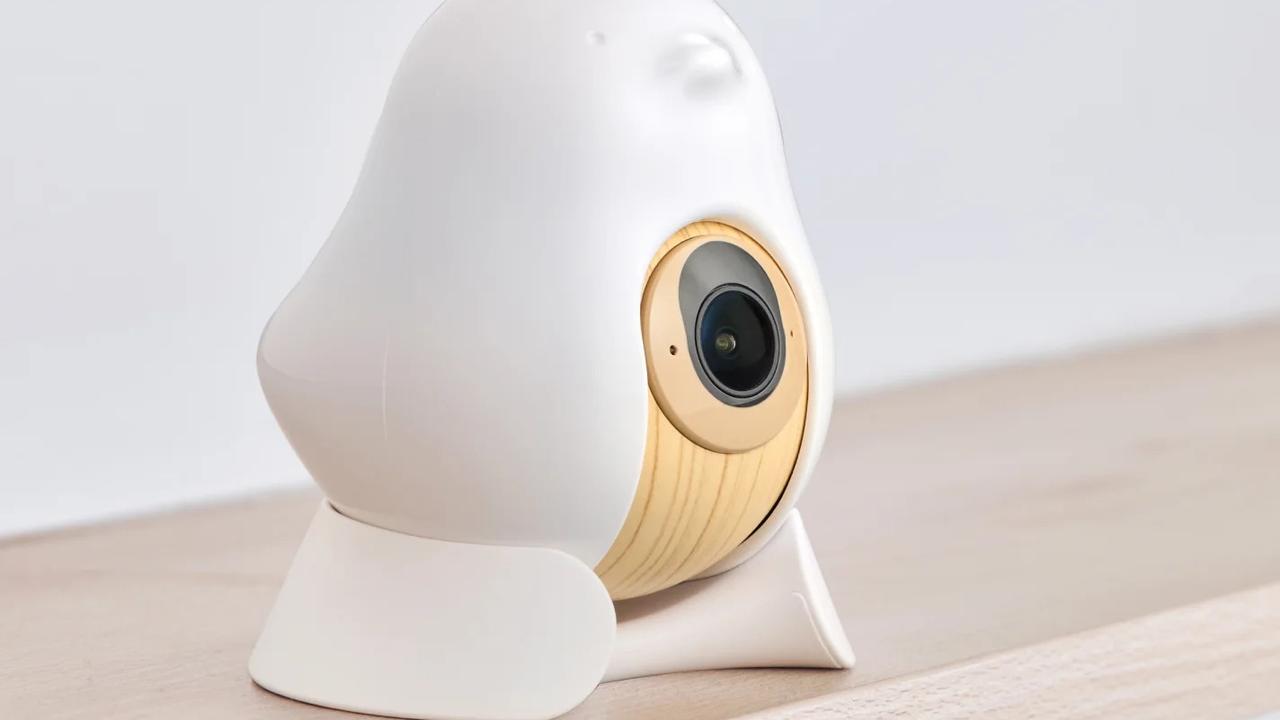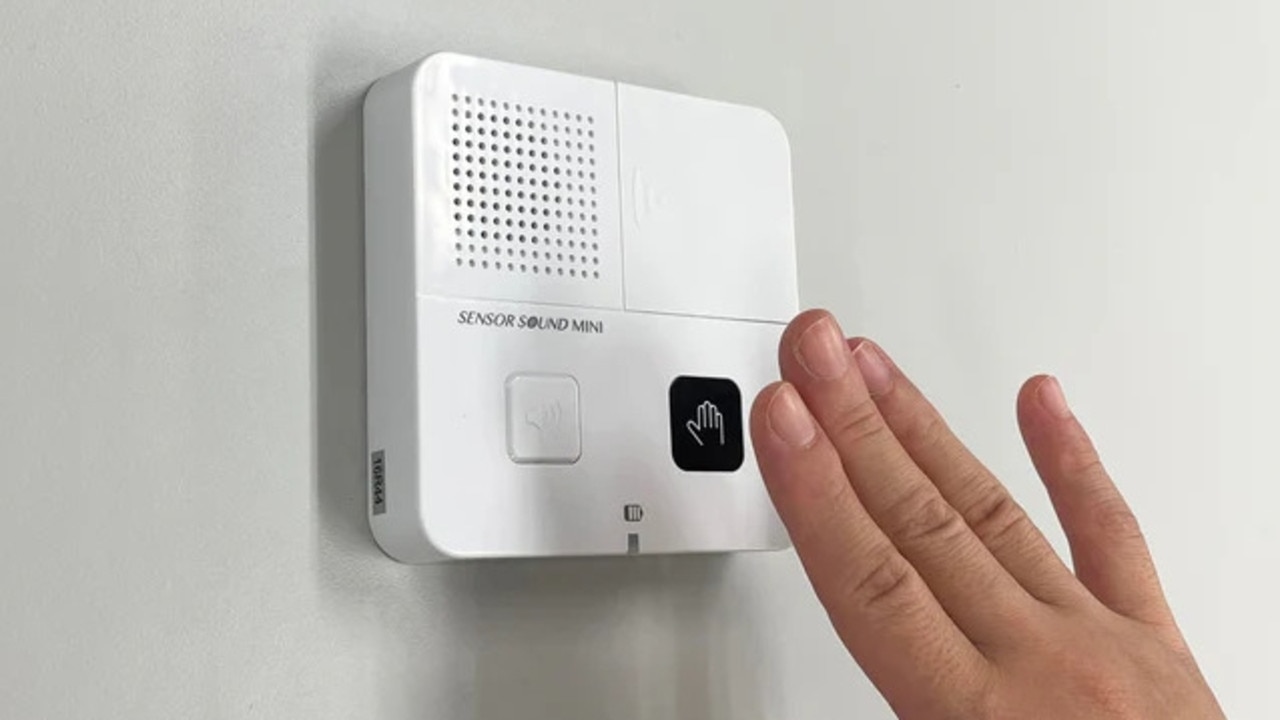Apple unveils new iPad Pros, iMacs, AirTags even purple phones
Bluetooth beacons that mean the search for your lost keys just got easier among an avalanche of new Apple products.
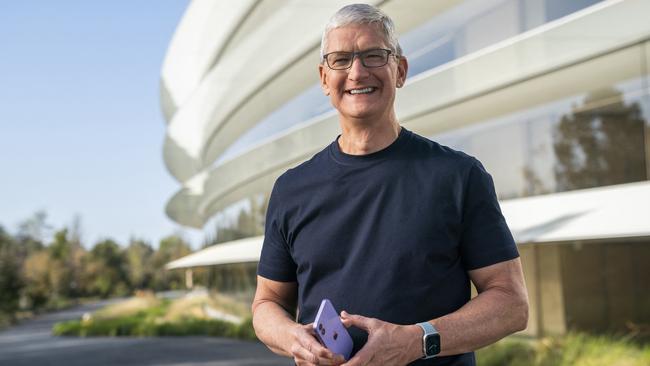
Apple has finally released its long awaited AirTags. They are small Bluetooth beacons that you attach to devices you want to track in case you lose them.
You might attach an AirTag to your house keys, a backpack, or luggage — anything you fear going missing. If you are familiar with the company Tile, you’ll recognise AirTags as similar to what Tile has offered for years.
Apple’s AirTag contains a battery that enables it to operate as a beacon for months, and you can recharge it when needed.
These little beacons work in two modes. If you lose your keys nearby, a nearby iPhone can detect it directly with Bluetooth.
Apple goes further, by using ultra-wideband and the camera, accelerometer and gyroscope in the phone to tell you how far away the missing device is, offering you visual feedback. You can get the device to play a sound if you cannot see it.
However, what if your keys are not under the couch, but seriously lost. You might have dropped them in the local shopping centre, or they could be on your desk at work, kilometres away.
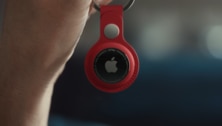
Apple has foreshadowed a second approach, namely invoking an anonymous army of nearly a billion or more iPhones out there. When someone else’s iPhone passes close to your keys at the shopping centre, it will alert the network and you will get to find out where they are.
The finder is not aware of what has happened, but you, the owner of the missing keys, hear all about it.
It is possible to locate missing devices that are offline in this way. Apple says it uses end-to-end encryption to protect the owner’s privacy in this network.
Apple already has offered a lost-and-found service using the Find Me app which can locate a missing iPhone, Apple Watch, iPad or Mac.
In future, users similarly will locate AirTags with the Find Me app. Apple also has struck a deal with companies that have embedded these beacons within their products, such as a US bicycle company. They too can be found using the Find Me app.
Apple says the AirTag system has been designed to be secure and private. That includes safety features so that Find Me tracks devices, and isn’t hijacked to find people.
“We included safety features to discourage unwanted tracking, like unwanted tag detection, rotating identifiers, and audible alerts from unknown tags,” said Apple at its Wednesday keynote.
Everyday versions of AirTags will be available from Apple from April 30 in Australia for $45 each, or four tags for $149. Apple also plans to sell a special handcrafted leather collection of AirTags, a bag charm, luggage tag and key ring each including an air tag.
It seems keeping tabs on your possessions is destined to be a fashion statement.
Belkin has announced it will also sell AirTag accessories.
Suite of new products
The AirTags release came as two new iPad Pros, seven coloured iMacs, a purple iPhone 12 and new Apple 4K TV were highlights of a power-packed one-hour unveiling event by Apple overnight.
The one hour smoothly-produced video event, held at 3am AEST, was Apple’s first announcement of new products for the year and there was a backlog of new tech to spruik. The Apple rumour mill had anticipated new iPad models and an iMac, but they underestimated the avalanche of new products to come.
iPad Pro
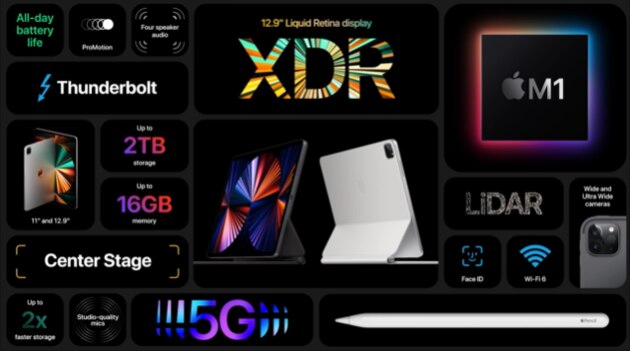
The iPad Pro was the most anticipated upgrade and Apple announced new 11-inch and 12.9-inch models. It really had to beef-up the iPad Pro because last year’s iPad Air was attractive enough to have some consumers wondering why bother with the more expensive Pros.
Now there are major points-of-difference. Apple has incorporated its home-designed M1 Apple Silicon processors, and in the case of the Pro models, it claims 50pc jump in CPU performance and 40pc jump in graphics performance on the previous iPads Pros.
This year Apple didn’t emphasise the iPad Pro’s capability to display augmented reality using the LIDAR depth scanner; the new features look decidedly more useful if you need them.
Cellular models support 5G and in the US (not Australia) the very fast mmWave 5G. The iPad Pro now supports Xbox and PlayStation games controllers and with its upgraded screen and faster processor, opens new possibilities for gamers.
On the data front, storage is faster, you can buy a Pro with 2 terabytes of storage that houses up to 220 hours of 4K HDR video, and, much anticipated, there is Thunderbolt with USB 4 support on its USB-C connector.
That speed will allow iPad Pro users to add very fast storage devices and even full resolution 6K displays to iPad Pro.
With video conferencing more prevalent due to the pandemic, Apple has included a wide-angle 1080p front facing camera that reframes the image to include new people joining in and a feature called Centre Stage that moves around as you move around, so that you are always in shot.
This dynamic movement capability is similar to a feature Google offers with its Nest Hub Max.
The iPad Pros piece-de-resistance is its liquid display: four million pixels on the 11-inch model with the 12.9-inch model using new mini-LED technology. This year we’ve already seen TV makers such as Samsung and Hisense announce TVs with tens of thousands of LEDs with much improved picture quality.
Apple says the 12.9-inch model has 10,000 LEDs compared to 72 in last year’s model. It’s also bringing the extreme dynamic range (aka XDR) meaning a huge range of colours found on its XDR display to iPad Pros and improved brightness and contrast.
Price: 11-inch iPad Pro from $1199, $1449 (cellular); 12.9-inch iPad Pro from $1649, $1899 (cellular). Order from April 30, available second half of May.
iMac
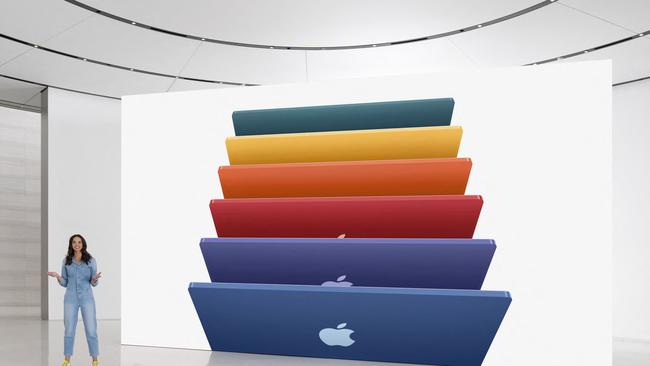
It was no secret that Apple would unveil new iMacs with M1 chips, given that it had withdrawn two iMac models from the Apple Store recently. There was a market void to fill.
However, it was not expected that Apple would release seven coloured 24-inch iMac models that are “bursting with colour”, each with a colour-coordinated mouse and trackpad.
We are still without a 32-inch iMac with the demise of the iMac Pro.
The new iMacs are extremely thin (11.5mm). Apple puts that down to the M1 chip being a system-on-a-chip and taking up less space than separate components did previously. That change also has seen the thermal system replaced with two small, quieter fans – under 10db.
Apple quantifies the 4.5K retina screen as displaying 11.3 million pixels, with 500 nits of brightness, and displaying more than a billion colours. You get a low-reflective coating and Apple says the iMac adjusts the screen’s colour temperature as the environment changes.

As with the iPad Pro, Apple has put effort into improving the front-facing camera now with HD resolution and a larger sensor for better low light performance.
Before your illustrious image gets sent to the internet, each pixel is transformed by Apple’s image signal processor (ISP) which it says performs more than a trillion operations per second – if you can believe that. There’s a three-mic array for sound.
There’s a six-speaker system, spatial audio, and Apple says thousands of apps have now been converted to work with Apple home grown processor used by iMac.
Apple’s device-to-device feature called continuity means calls and texts can be switched from an iPhone to iMac, and you can copy text and images on iPhone onto an iMac with universal clipboard, and paste them into an iMac document.
There’s 4 USB-C ports (two with Thunderbolt support) and support for a 6K display, a fashion-coloured woven cable to make your cable clutter look more respectable, and an Ethernet socket on the cable to reduce that clutter altogether. And yes, there is at last touch ID fingerprint authentication on iMac. Some have waited years for this.
There are two versions: 7-core GPU and 8-core GPU. 7-core GPU iMacs come in green, pink, blue and silver, while 8-core versions additionally come in yellow, orange and purple.
Price: From $1899 (7-core GPU), $2199 (8-core GPU). Order from April 30, available second half of May.
Apple 4K TV
Apple announced what is basically a refresh of Apple TV. The company already has a 4K version in the market, however this new model uses Apple’s A12 Bionic chip (not the M1 suprisingly) and supports high frame rate HDR and Dolby Vision.
The highlight is the new Siri remote control which Apple says can also control your TV. It includes a clickpad with five-way navigation, and you can use a circular gesture for forward and backward through a movie.
If you already have an Apple TV, you can buy the Siri remote separately.
Price: $209 for Apple TV 4K with Siri remote, $79 for the remote alone. Order from April 30, available second half of May.
Purple iPhone 12 and 12 mini
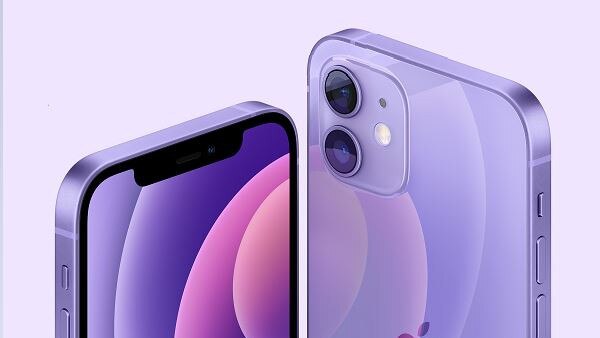
Apple CEO Tim Cook says the new purple iPhone 12/12 mini is “perfect for Spring” which is great if you live in the northern hemisphere. Fortunately purple might match the colour of some falling leaves in Australia.
Whatever the case, you can soon buy a purple iPhone. This item was introduced with “The Candy Man can” song. Enough said.
Order from 10pm, April 23, available April 30.
Subscription podcasts
Apple has revamped the podcast app so you can subscribe to podcasts and enjoy add-free content and early releases. This will be good news for podcast publishers, although users will no doubt grumble about paying for podcasts that previously were free. Creators decide the subscription costs.
There are cosmetic changes to the app.” Every show and podcast has a beautiful new page,” says Apple CEO Tim Cook. There are also now channels for helping users find content.
I hope Apple has thought about fixing one or two irritations of this app. I find it replays podcasts I have already listened to, unless I actively delete them.
Reaction
We’re seeing more of Apple using this format to bundle together a swag of new device and service announcements.
Not everyone is cock-a-hoop about the direction Apple is going. London-based GlobalData says Apple continues to want to draw users further into its ecosystem. But that‘s business.
“What may seem like a hodgepodge of new product features and enhancements that Apple announced today largely points to one thing: locking users into the Apple ecosystem, says Lynnette Luna, Principal Analyst at GlobalData.
“The ecosystem message was strong. Nearly every product announcement was about how well each product or service works together. That continues to be a significant weakness of rival Samsung.
“Apple TV’s enhancements hit on how well the hardware works with the iPhone to balance and check colour on any TV. The new iMac, while seeing significant hardware enhancements, also highlighted the ability to hand off capabilities between the iMac and other devices, using the iPhone as an example.
“Apple’s biggest announcement was the new iPad Pro with a new M1 chip and 5G capabilities, which should help carriers in their quest to sell new 5G subscriptions. A new ultra wide camera on the iPad Pro pans automatically to follow users as they move around and widens out if a second person enters the screen. The feature rivals Facebook Portal and Amazon Echo.”
We’ll see how useful this new tech is when we get hands on and review it.

